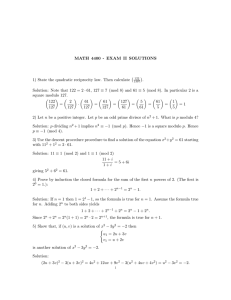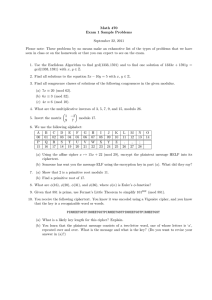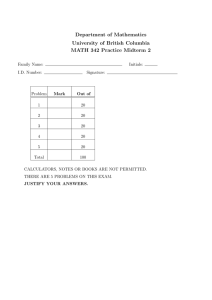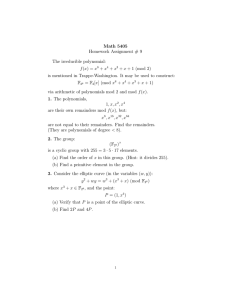Mathematics 366 Homework (2 weeks – due Sep. 16) A. Hulpke
advertisement
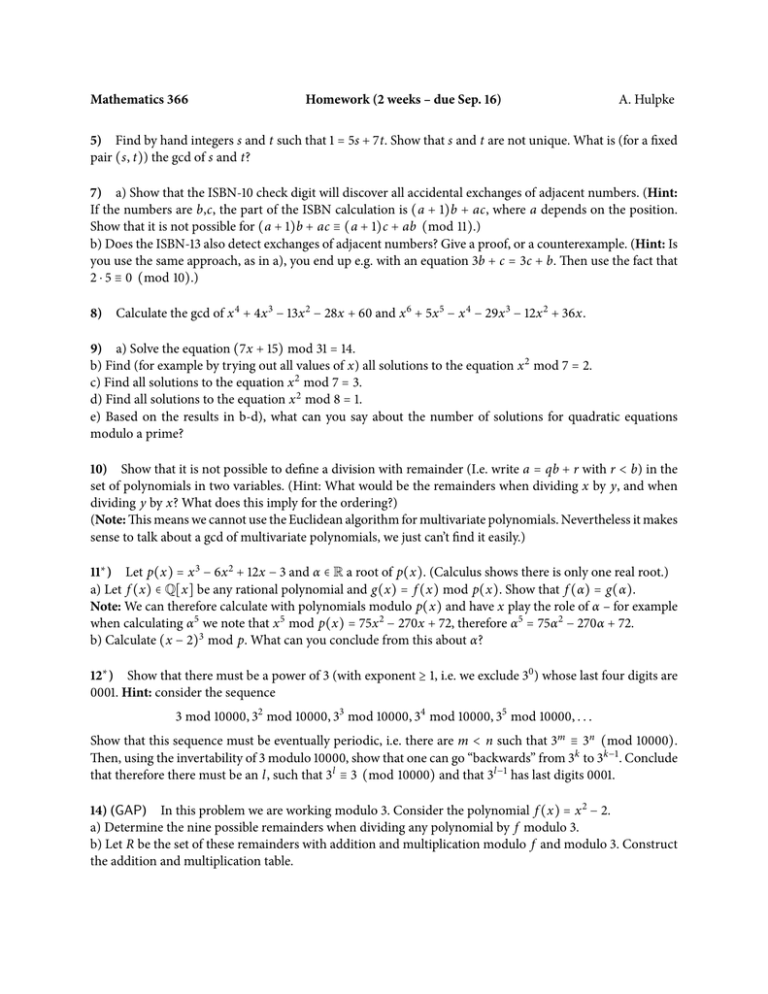
Mathematics 366
Homework (2 weeks – due Sep. 16)
A. Hulpke
5) Find by hand integers s and t such that 1 = 5s + 7t. Show that s and t are not unique. What is (for a fixed
pair (s, t)) the gcd of s and t?
7) a) Show that the ISBN-10 check digit will discover all accidental exchanges of adjacent numbers. (Hint:
If the numbers are b,c, the part of the ISBN calculation is (a + 1)b + ac, where a depends on the position.
Show that it is not possible for (a + 1)b + ac ≡ (a + 1)c + ab (mod 11).)
b) Does the ISBN-13 also detect exchanges of adjacent numbers? Give a proof, or a counterexample. (Hint: Is
you use the same approach, as in a), you end up e.g. with an equation 3b + c = 3c + b. Then use the fact that
2 ⋅ 5 ≡ 0 (mod 10).)
8)
Calculate the gcd of x 4 + 4x 3 − 13x 2 − 28x + 60 and x 6 + 5x 5 − x 4 − 29x 3 − 12x 2 + 36x.
9) a) Solve the equation (7x + 15) mod 31 = 14.
b) Find (for example by trying out all values of x) all solutions to the equation x 2 mod 7 = 2.
c) Find all solutions to the equation x 2 mod 7 = 3.
d) Find all solutions to the equation x 2 mod 8 = 1.
e) Based on the results in b-d), what can you say about the number of solutions for quadratic equations
modulo a prime?
10) Show that it is not possible to define a division with remainder (I.e. write a = qb + r with r < b) in the
set of polynomials in two variables. (Hint: What would be the remainders when dividing x by y, and when
dividing y by x? What does this imply for the ordering?)
(Note: This means we cannot use the Euclidean algorithm for multivariate polynomials. Nevertheless it makes
sense to talk about a gcd of multivariate polynomials, we just can’t find it easily.)
11∗ ) Let p(x) = x 3 − 6x 2 + 12x − 3 and α ∈ R a root of p(x). (Calculus shows there is only one real root.)
a) Let f (x) ∈ Q[x] be any rational polynomial and g(x) = f (x) mod p(x). Show that f (α) = g(α).
Note: We can therefore calculate with polynomials modulo p(x) and have x play the role of α – for example
when calculating α 5 we note that x 5 mod p(x) = 75x 2 − 270x + 72, therefore α 5 = 75α 2 − 270α + 72.
b) Calculate (x − 2)3 mod p. What can you conclude from this about α?
12∗ ) Show that there must be a power of 3 (with exponent ≥ 1, i.e. we exclude 30 ) whose last four digits are
0001. Hint: consider the sequence
3 mod 10000, 32 mod 10000, 33 mod 10000, 34 mod 10000, 35 mod 10000, . . .
Show that this sequence must be eventually periodic, i.e. there are m < n such that 3m ≡ 3n (mod 10000).
Then, using the invertability of 3 modulo 10000, show that one can go “backwards” from 3k to 3k−1 . Conclude
that therefore there must be an l, such that 3l ≡ 3 (mod 10000) and that 3l−1 has last digits 0001.
14) (GAP) In this problem we are working modulo 3. Consider the polynomial f (x) = x 2 − 2.
a) Determine the nine possible remainders when dividing any polynomial by f modulo 3.
b) Let R be the set of these remainders with addition and multiplication modulo f and modulo 3. Construct
the addition and multiplication table.
15) Consider the set R = {(a, b) ∣ a, b ∈ Z}. We define an addition and a multiplication by
(a, b) + (c, d) = (a + c, b + d)
(a, b) ⋅ (c, d) = (ac − bd, ad + bc)
a) Show that with these operations R becomes a ring. Is it commutative? Does it have an identity element?
b) Show that the set S = {(a, b) ∈ R ∣ a, b even} is a subring.
⎧
⎫
a
⎪
⎪
⎪
⎪
⎪⎛ ⎞
⎪
16) Consider the set R = ⎨⎜ b ⎟ ∣ a, b, c ∈ R⎬ of vectors. If we consider the usual addition and the cross
⎪
⎪
⎪
⎪
⎪
⎪
⎩⎝ c ⎠
⎭
product
⎛ a ⎞ ⎛ d ⎞ ⎛ b f − ec ⎞
⎜ b ⎟ × ⎜ e ⎟ = ⎜ dc − a f ⎟
⎝ c ⎠ ⎝ f ⎠ ⎝ ae − bd ⎠
as multiplication, is this set a ring?
17) Which of the following sets are rings (with the usual addition and multiplication)? Do they have an
identity?
1. The natural numbers;
2. real polynomials of degree at most n;
3. polynomials with integer coefficients;
4. polynomials with integer coefficients and constant term zero;
5. polynomials with integer coefficients and degree at most four;
6. all real polynomials such that p(2) = 0;
7. all integers divisible by 3;
8. all non-singular 2 × 2 matrices with real entries.
Hint: It might be easiest to show that a set is a subring of a larger ring.
18∗ ) Let R = Z. Define a new addition and a multiplication, that makes R a ring, but such that 0 is not the
zero element of R and 1 not the one.
Hint: Consider a ⊕ b = ((a − 3) + (b − 3)) + 3
19) Show that the ring R of 2 × 2 matrices with rational entries contains elements a, b ∈ R such that ab = 0
but ba =/ 0.
Problems marked with a ∗ are bonus problems for extra credit.



